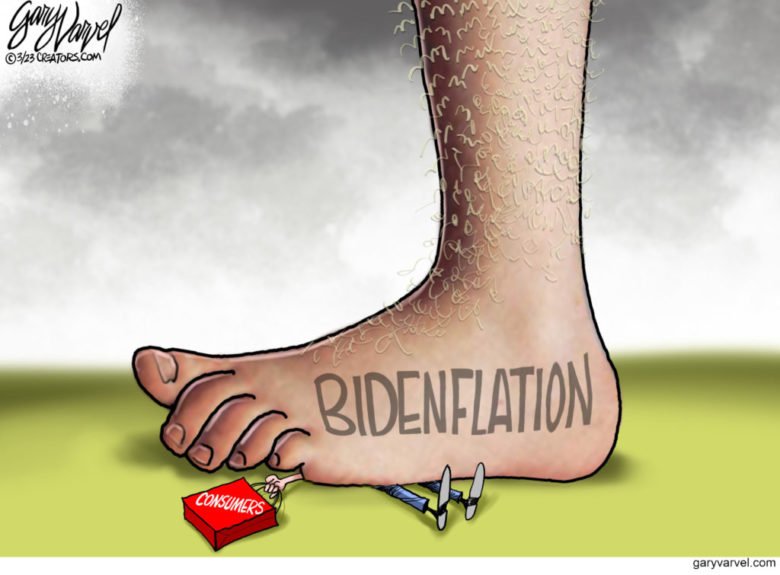Inflation continues to dog Americans thanks in large part to sky-high housing costs, which aren’t going away any time soon.
The cost of renting or buying a home has increased dramatically since Biden first took office, rising 5.65% from a year ago and 20.5% since January 2021, according to the Federal Reserve Bank of St. Louis. In March, price increases in shelter and gasoline contributed to over half of the overall price level increase, with shelter prices having risen 0.4% or more per month since November, according to the Bureau of Labor Statistics.
Due to the “stickiness” of housing prices from long-term agreements like lease terms and difficulties immediately expanding housing supply, cost increases aren’t expected to decline anytime soon, painting a grim picture of the possibility of reining in inflation.
“The pandemic initially slowed the housing market due to lockdowns and economic uncertainty,” Peter Earle, economist at the American Institute for Economic Research, told the Daily Caller News Foundation. “Inflation certainly drove housing prices, but additionally, the combination of remote work and low interest rates drove demand for suburban and rural homes. That led to even more surging prices and eventually bidding wars among limited inventory.”
The Case-Shiller U.S. National Home Price Index increased 6.0% year-over-year in January, the fastest rate since November 2022 and up from 5.6% in the previous month. The rate of increases in home prices has been accelerating since May 2023, when it declined slightly year-over-year.
Renting unaffordability recently reached an all-time high, with 22.4 million households spending more than 30% of their income on rent and utilities, which is up by two million in just three years. The loss in affordability accompanies a drop in low-cost rent units, meaning those below $600 a month, adjusted for inflation, which has fallen by 2.1 million since 2012.
Most new developments that have been constructed in recent years have targeted upper-class customers, lowering prices for wealthier Americans but doing nothing to alleviate supply for standard units. The number of apartments added to the market was a 36-year high in 2023 but failed to effectively reduce shelter prices for average Americans, according to Realpage.
Shelter inflation in the United States remains a major issue as it stands at 5.7%.
Inflation for renters was 5.68% in March while inflation for homeowners was 5.65%.
The median national rent price for a single family home is nearly $2,000/month.
Meanwhile, the median payment… pic.twitter.com/V4UjOdWKbu
— The Kobeissi Letter (@KobeissiLetter) April 11, 2024
“The reason why higher interest rates haven’t slowed the rise of prices in shelter has to do with the ‘stickiness’ of prices in those areas,” Earle told the DCNF. “The commercial nature of rents and mortgages is that they are contractually agreed to. Monthly rents only change every year or two, and mortgage payments may not change for even longer periods of time. For that reason, price changes in those businesses are slow to materialize.”
Inflation overall increased to 3.5% year-over-year in March, rising from 3.2% in February and far higher than the Federal Reserve’s 2% target. In response to high inflation, the Fed has placed its federal funds rate in a range of 5.25% and 5.50%, the highest in 23 years, raising the cost of credit across the board.
Due to an increase in the cost of credit, developers are currently disincentivized from obtaining capital to construct new homes, dampening new construction that could alleviate price pressures, according to Forbes Advisor. Existing homeowners are also disincentivized from selling their homes, as they would have to give up their current mortgage rate for possibly a much higher rate, further tightening supply, particularly for starter homes that Americans move out of as they get older.
Mortgage rates are particularly responsive to increases in the federal funds rate, tracking closely to Treasury yields that measure future rate expectations. The average for a 30-year mortgage neared 7% as of Thursday, rising from a recent low of below 3% at the start of 2021, according to Freddie Mac.
The Biden administration, in its budget proposal for fiscal year 2025, asked for $258 billion to boost housing supply and alleviate unaffordability. The plan could boost housing supply once the funds are actually appropriated, but it would add more fuel to inflation due to the need to fund the increase in spending with debt without addressing the key constraint of high interest rates on private developers who drive shelter creation.
“If there is one thing that we can hope to salvage from this ongoing inflationary ordeal, it’s the hope that some years from now, when some politician or bureaucrat recommends using money printing to address a problem, people remember that once that cat is out of the bag, it takes years to capture,” Earle told the DCNF.
The White House did not immediately respond to a request to comment from the Daily Caller News Foundation.
Content created by The Daily Caller News Foundation is available without charge to any eligible news publisher that can provide a large audience. For licensing opportunities of our original content, please contact licensing@dailycallernewsfoundation.org

